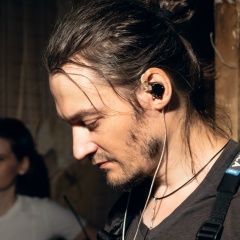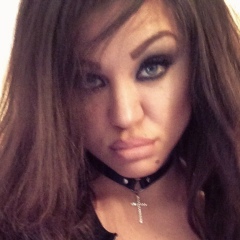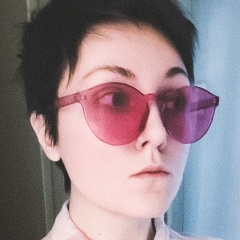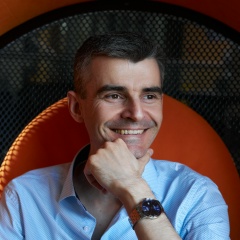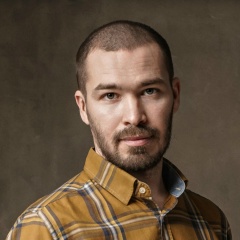Поговорим о съемке животных.
Многие, собираясь поснимать дикую природу, или спорт, наивно рассчитывают на то, что в их камере есть следящий фокус и вот он-то, особенно на дешевом объективе, сделает всю грязную работу за нас.
Не столько важна сама техника (хотя и она кое что позволяет), сколько понимание специфики? Вот чем съемка собачьих бегов отличается от съемки сусликов? В обоих случаях мы снимаем в движении. На форумах советуют: "некогда объяснять, включай следящий автофокус". Чем он от обычного-то отличается? Только тем, что сам отслеживает перемещение объекта в пространстве. Но есть много но:
1) Автофокусу нужен контраст между объектом и фоном, чтобы "зацепиться". Если суслик сливается с окружающей средой, или во время соревнований пошел снег - контраста не будет. Как в случае с собакой - мы вообще можем получить в резкости снежинку. И пока мы вертим камеру с недовольным лицом из-за неожиданных сюрпризов - моменты исчезают и съемка выходит далеко не самой интересной. Все интересное мы доверили автофокусу, но подвел нас не он, а мы сами себя, не учитывая особенности съемки.
2) Автофокус отслеживает перемещение объектов не на скорости света. Чаще всего существуют ограничения. К примеру, Салюки (арабская борзая) может развивать скорость до 70 км/ч. А профессиональные камеры и оптика позволяют удерживать в фокусе скорости порядка 50 км/ч. Кроме того, 50км/ч на расстоянии километра и 50 км/ч на расстоянии десятка метров - совершенно разное ощущение. Замечали, что несущаяся на вас машина не выглядит опасной на расстоянии и только в последний момент, перебегая дорогу, понимаешь, что повезло? Вот это ощущение скорости, зависящее от расстояния, влияет не только на наши способности оценивать ситуацию, но и на работу автофокуса. Из-за зависимости глубины резкости от расстояния до объекта, камере легче удерживать в резкости объекты на больших дистанциях. В этом смысле удобнее снимать тогда, когда объект движется мимо нас на средних расстояниях, что дает минимальные изменения дистанции между нами и объектом + съемка в профиль дает более читаемые по силуэтам снимки.
3) Дистанции. Проблема не только в том, что на близких дистанциях камера не успевает перемещать стекла в объективах с нужной скоростью. Проблема в том, что не все объективы позволяют снимать на близком расстоянии. Суслика с расстояния 30 метров снимать трудно объективами типа 70-200, или 300мм, потому что он маленький. А брать 400, или 600мм оптику - дорого (если профессиональная оптика), или не удобно (ручки-то трясутся). А ближе подойти - тоже не каждый может (Тут мы вспоминаем, что орнитолог снимает лучше фотографа, потому что знает каких птиц когда и где искать, а так же как к ним подкрадываться). Но самая большая проблема - это если объект приближается к нам на дистанцию меньше той, которую позволяет использовать объектив. К примеру верхний кадр с сусликом: суслик был близко - рукой схватить можно, но объектив не фокусируется ближе 45см, а у суслика ограничений по перемещению нет. Один Шаг и он вышел из резкости. Никакой Nikon D5 вам не поможет. И не забываем - чем ближе объект, тем сложнее камере его удерживать в фокусе. В этом смысле в макросъемке автофокус вообще бесполезен. Важнее - масштаб. Помните, что если объект занимает весь кадр и это маленький и шустрый объект, то выпасть из кадра он может за сотые доли секунды. Потому что мелкие животные и насекомые, относительно размеров своего тела, двигаются быстрее слонов. Камера за вас сбежавшего из кадра муравья не найдет.
4) Масштаб. Если мы определились с тем, какого размера в кадре должен быть объект - достаточно оказаться на этом расстоянии. Вспоминаем поговорку: "На ловца и зверь бежит" и задумываемся заранее о том, как заставить объект находиться на нужном расстоянии. Если это не спорт, то обстановка спокойная. Фотограф в засидке в безопасном месте и никаких тревог для животных нет. Снимайте на здоровье. Спорт - другое дело. Нужно занимать подходящие точки съемки. Что касается бегов за механическим зайцем - достаточно знать траектории, чтобы стоять там, где снимать удобно пробегающую мимо собаку.
5) Лень. Большинство плохих кадров и еще более ужасных дублей - от лени. Напрягайте мозг, чтобы оценивать происходящее. Отстреливаться во все стороны от страха не наш путь. К примеру, нижний кадр с сусликом снят на механический объектив Carl Zeiss T* 50/1.4. Пока мои коллеги пытались сделать хоть кадр - я сделал много хороших с ручной фокусировкой. Мне достаточно было контролировать дистанцию, вообще не трогая фокусировочное кольцо, потому что я просто аранее решил какие кадры мне нужны. И то от брака вы не застрахованы (см. пункт 3). Чтобы понять то, на сколько сложно снимать сусликов - посмотрите видео:
Многие, собираясь поснимать дикую природу, или спорт, наивно рассчитывают на то, что в их камере есть следящий фокус и вот он-то, особенно на дешевом объективе, сделает всю грязную работу за нас.
Не столько важна сама техника (хотя и она кое что позволяет), сколько понимание специфики? Вот чем съемка собачьих бегов отличается от съемки сусликов? В обоих случаях мы снимаем в движении. На форумах советуют: "некогда объяснять, включай следящий автофокус". Чем он от обычного-то отличается? Только тем, что сам отслеживает перемещение объекта в пространстве. Но есть много но:
1) Автофокусу нужен контраст между объектом и фоном, чтобы "зацепиться". Если суслик сливается с окружающей средой, или во время соревнований пошел снег - контраста не будет. Как в случае с собакой - мы вообще можем получить в резкости снежинку. И пока мы вертим камеру с недовольным лицом из-за неожиданных сюрпризов - моменты исчезают и съемка выходит далеко не самой интересной. Все интересное мы доверили автофокусу, но подвел нас не он, а мы сами себя, не учитывая особенности съемки.
2) Автофокус отслеживает перемещение объектов не на скорости света. Чаще всего существуют ограничения. К примеру, Салюки (арабская борзая) может развивать скорость до 70 км/ч. А профессиональные камеры и оптика позволяют удерживать в фокусе скорости порядка 50 км/ч. Кроме того, 50км/ч на расстоянии километра и 50 км/ч на расстоянии десятка метров - совершенно разное ощущение. Замечали, что несущаяся на вас машина не выглядит опасной на расстоянии и только в последний момент, перебегая дорогу, понимаешь, что повезло? Вот это ощущение скорости, зависящее от расстояния, влияет не только на наши способности оценивать ситуацию, но и на работу автофокуса. Из-за зависимости глубины резкости от расстояния до объекта, камере легче удерживать в резкости объекты на больших дистанциях. В этом смысле удобнее снимать тогда, когда объект движется мимо нас на средних расстояниях, что дает минимальные изменения дистанции между нами и объектом + съемка в профиль дает более читаемые по силуэтам снимки.
3) Дистанции. Проблема не только в том, что на близких дистанциях камера не успевает перемещать стекла в объективах с нужной скоростью. Проблема в том, что не все объективы позволяют снимать на близком расстоянии. Суслика с расстояния 30 метров снимать трудно объективами типа 70-200, или 300мм, потому что он маленький. А брать 400, или 600мм оптику - дорого (если профессиональная оптика), или не удобно (ручки-то трясутся). А ближе подойти - тоже не каждый может (Тут мы вспоминаем, что орнитолог снимает лучше фотографа, потому что знает каких птиц когда и где искать, а так же как к ним подкрадываться). Но самая большая проблема - это если объект приближается к нам на дистанцию меньше той, которую позволяет использовать объектив. К примеру верхний кадр с сусликом: суслик был близко - рукой схватить можно, но объектив не фокусируется ближе 45см, а у суслика ограничений по перемещению нет. Один Шаг и он вышел из резкости. Никакой Nikon D5 вам не поможет. И не забываем - чем ближе объект, тем сложнее камере его удерживать в фокусе. В этом смысле в макросъемке автофокус вообще бесполезен. Важнее - масштаб. Помните, что если объект занимает весь кадр и это маленький и шустрый объект, то выпасть из кадра он может за сотые доли секунды. Потому что мелкие животные и насекомые, относительно размеров своего тела, двигаются быстрее слонов. Камера за вас сбежавшего из кадра муравья не найдет.
4) Масштаб. Если мы определились с тем, какого размера в кадре должен быть объект - достаточно оказаться на этом расстоянии. Вспоминаем поговорку: "На ловца и зверь бежит" и задумываемся заранее о том, как заставить объект находиться на нужном расстоянии. Если это не спорт, то обстановка спокойная. Фотограф в засидке в безопасном месте и никаких тревог для животных нет. Снимайте на здоровье. Спорт - другое дело. Нужно занимать подходящие точки съемки. Что касается бегов за механическим зайцем - достаточно знать траектории, чтобы стоять там, где снимать удобно пробегающую мимо собаку.
5) Лень. Большинство плохих кадров и еще более ужасных дублей - от лени. Напрягайте мозг, чтобы оценивать происходящее. Отстреливаться во все стороны от страха не наш путь. К примеру, нижний кадр с сусликом снят на механический объектив Carl Zeiss T* 50/1.4. Пока мои коллеги пытались сделать хоть кадр - я сделал много хороших с ручной фокусировкой. Мне достаточно было контролировать дистанцию, вообще не трогая фокусировочное кольцо, потому что я просто аранее решил какие кадры мне нужны. И то от брака вы не застрахованы (см. пункт 3). Чтобы понять то, на сколько сложно снимать сусликов - посмотрите видео:
Talk about shooting animals.
Many, intending to take pictures of wildlife, or sports, naively rely on the fact that there is a tracking focus in their camera and that he, especially on a cheap lens, will do all the dirty work for us.
Not so much the technique itself is important (although it does allow something), how much is understanding the specifics? So how is shooting dog racing different from shooting gophers? In both cases, we shoot in motion. The forums advise: "no time to explain, turn on tracking autofocus." How is it different from usual? Only by the fact that he himself tracks the movement of an object in space. But there are many but:
1) Autofocus needs a contrast between the subject and the background in order to “catch on”. If the gopher merges with the environment, or it snows during the competition, there will be no contrast. As in the case of a dog, we can generally get a sharp snowflake. And while we are turning the camera with a displeased face due to unexpected surprises - the moments disappear and the shooting is far from the most interesting. We entrusted everything of interest to autofocus, but it was not he who let us down, but we ourselves, not taking into account the particularities of shooting.
2) Autofocus does not track the movement of objects at the speed of light. Most often, there are limitations. For example, Salyuki (Arabian Greyhound) can reach speeds of up to 70 km / h. And professional cameras and optics allow you to keep in focus speeds of about 50 km / h. In addition, 50km / h at a distance of a kilometer and 50 km / h at a distance of a dozen meters - a completely different feeling. Have you noticed that the car rushing towards you does not look dangerous at a distance and only at the last moment, crossing the road, do you understand what is lucky? This feeling of speed, depending on the distance, affects not only our ability to assess the situation, but also the autofocus. Due to the dependence of the depth of field on the distance to the object, it is easier for the camera to keep objects in sharpness at large distances. In this sense, it’s more convenient to shoot when the object moves past us at medium distances, which gives minimal changes in the distance between us and the object + profile shots give more readable images in silhouette.
3) Distances. The problem is not only that at close distances the camera does not have time to move the glass in the lenses at the right speed. The problem is that not all lenses allow you to shoot at close range. It is difficult to shoot a gopher from a distance of 30 meters with lenses such as 70-200, or 300mm, because it is small. And to take 400, or 600mm optics is expensive (if professional optics), or not convenient (handles are shaking). And not everyone can come any closer (Here we recall that an ornithologist shoots better than a photographer, because he knows which birds when and where to look for, as well as how to sneak up on them). But the biggest problem is if the object is closer to us than the distance that the lens allows us to use. For example, the top frame with a gopher: the gopher was close - you can grab it with your hand, but the lens does not focus closer than 45 cm, and the gopher has no restrictions on movement. One Step and he went out of harshness. No Nikon D5 will help you. And do not forget - the closer the subject, the more difficult it is for the camera to keep it in focus. In this sense, autofocus is generally useless in macro photography. More important is scale. Remember that if an object occupies the entire frame and it is a small and nimble object, then it can fall out of the frame in hundredths of a second. Because small animals and insects, relative to the size of their bodies, move faster than elephants. The camera will not find an ant escaping from the frame for you.
4) Scale. If we decided on what size the object should be in the frame, it is enough to be at this distance. We recall the proverb: “The beast runs to the catcher” and think ahead of time about how to make the object be at the right distance. If this is not a sport, then the situation is calm. The photographer is sitting in a safe place and there is no alarm for the animals. Take off to health. Sport is another matter. It is necessary to occupy suitable shooting points. As for running for a mechanical hare, it is enough to know the trajectories to stand where to shoot a dog conveniently running past.
5) Laziness. Most bad shots and even more terrible takes are from laziness. Strain your brain to evaluate what is happening. Shooting in all directions from fear is not our way. For example, the lower frame with a gopher was shot on a Carl Zeiss T * 50 / 1.4 mechanical lens. While my colleagues tried to make at least a shot, I did a lot of good ones with manual focus. It was enough for me to control the distance without touching the focus ring at all, because I just decided earlier what frames I needed. And then you are not safe from marriage (see paragraph 3). To understand how difficult it is to shoot gophers - watch the video:
Many, intending to take pictures of wildlife, or sports, naively rely on the fact that there is a tracking focus in their camera and that he, especially on a cheap lens, will do all the dirty work for us.
Not so much the technique itself is important (although it does allow something), how much is understanding the specifics? So how is shooting dog racing different from shooting gophers? In both cases, we shoot in motion. The forums advise: "no time to explain, turn on tracking autofocus." How is it different from usual? Only by the fact that he himself tracks the movement of an object in space. But there are many but:
1) Autofocus needs a contrast between the subject and the background in order to “catch on”. If the gopher merges with the environment, or it snows during the competition, there will be no contrast. As in the case of a dog, we can generally get a sharp snowflake. And while we are turning the camera with a displeased face due to unexpected surprises - the moments disappear and the shooting is far from the most interesting. We entrusted everything of interest to autofocus, but it was not he who let us down, but we ourselves, not taking into account the particularities of shooting.
2) Autofocus does not track the movement of objects at the speed of light. Most often, there are limitations. For example, Salyuki (Arabian Greyhound) can reach speeds of up to 70 km / h. And professional cameras and optics allow you to keep in focus speeds of about 50 km / h. In addition, 50km / h at a distance of a kilometer and 50 km / h at a distance of a dozen meters - a completely different feeling. Have you noticed that the car rushing towards you does not look dangerous at a distance and only at the last moment, crossing the road, do you understand what is lucky? This feeling of speed, depending on the distance, affects not only our ability to assess the situation, but also the autofocus. Due to the dependence of the depth of field on the distance to the object, it is easier for the camera to keep objects in sharpness at large distances. In this sense, it’s more convenient to shoot when the object moves past us at medium distances, which gives minimal changes in the distance between us and the object + profile shots give more readable images in silhouette.
3) Distances. The problem is not only that at close distances the camera does not have time to move the glass in the lenses at the right speed. The problem is that not all lenses allow you to shoot at close range. It is difficult to shoot a gopher from a distance of 30 meters with lenses such as 70-200, or 300mm, because it is small. And to take 400, or 600mm optics is expensive (if professional optics), or not convenient (handles are shaking). And not everyone can come any closer (Here we recall that an ornithologist shoots better than a photographer, because he knows which birds when and where to look for, as well as how to sneak up on them). But the biggest problem is if the object is closer to us than the distance that the lens allows us to use. For example, the top frame with a gopher: the gopher was close - you can grab it with your hand, but the lens does not focus closer than 45 cm, and the gopher has no restrictions on movement. One Step and he went out of harshness. No Nikon D5 will help you. And do not forget - the closer the subject, the more difficult it is for the camera to keep it in focus. In this sense, autofocus is generally useless in macro photography. More important is scale. Remember that if an object occupies the entire frame and it is a small and nimble object, then it can fall out of the frame in hundredths of a second. Because small animals and insects, relative to the size of their bodies, move faster than elephants. The camera will not find an ant escaping from the frame for you.
4) Scale. If we decided on what size the object should be in the frame, it is enough to be at this distance. We recall the proverb: “The beast runs to the catcher” and think ahead of time about how to make the object be at the right distance. If this is not a sport, then the situation is calm. The photographer is sitting in a safe place and there is no alarm for the animals. Take off to health. Sport is another matter. It is necessary to occupy suitable shooting points. As for running for a mechanical hare, it is enough to know the trajectories to stand where to shoot a dog conveniently running past.
5) Laziness. Most bad shots and even more terrible takes are from laziness. Strain your brain to evaluate what is happening. Shooting in all directions from fear is not our way. For example, the lower frame with a gopher was shot on a Carl Zeiss T * 50 / 1.4 mechanical lens. While my colleagues tried to make at least a shot, I did a lot of good ones with manual focus. It was enough for me to control the distance without touching the focus ring at all, because I just decided earlier what frames I needed. And then you are not safe from marriage (see paragraph 3). To understand how difficult it is to shoot gophers - watch the video:

У записи 12 лайков,
0 репостов,
580 просмотров.
0 репостов,
580 просмотров.
Эту запись оставил(а) на своей стене Дмитрий Скобелев

